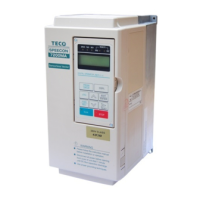58
(33)Low Voltage Alarm Detection Level (Cn-39)
•In most cases, the default setting Cn-39 need not be changed. If an external AC
reactor is used, decrease the low voltage alarm detection level by adjusting Cn-39
setting smaller. Be sure to set a main-circuit DC voltage so that a main circuit
undervoltage is detected.
(34)Slip Compensation Primary Delay Time (Cn-40)
•In most cases, the setting Cn-40 need not be changed. If the motor speed is not
stable, increase the Cn-40 setting. If the speed response is slow, decrease the
setting of Cn-40.
(35)S-curve Characteristic Time at Acceleration Start (Cn-41)
(36)S-curve Characteristic Time at Acceleration End (Cn-42)
(37)S-curve Characteristic Time at Deceleration Start (Cn-43)
(38)S-curve Characteristic Time at Deceleration End (Cn-44)
•Using the S-curve characteristic function for acceleration and deceleration can
reduce shock to the machinery when stopping and starting. With the inverter, S-
curve characteristic time can be set respectively for beginning acceleration, ending
acceleration, beginning deceleration and ending deceleration. The relation between
these parameters is shown in Fig. 28.
Output
frequency
Time
Cn-41
Cn-42 Cn-43
Cn-44
ON
OFF
Run
command
S1
S2
S4
S3
Fig. 28 S curve
•After the S-curve time is set, the final acceleration and deceleration time will be as
follows:
(Cn-41) + (Cn-42)
•
Acc. time = selected Acc. Time 1 (or 2) +
2
(Cn-43) + (Cn-44)
•
Dec. time = selected Dec. Time 1 (or 2) +
2

